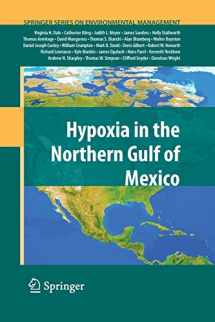
Hypoxia in the Northern Gulf of Mexico (Springer Series on Environmental Management)
ISBN-13:
9781461425687
ISBN-10:
1461425689
Edition:
2010
Author:
Virginia H. Dale, Thomas Armitage, James Sanders, Mark David, Catherine L. Kling, Judith L. Meyer, Holly Stallworth, David Wangsness, Thomas Bianchi, Alan Blumberg, Walter Boynton, Daniel J. Conley, William Crumpton, Denis Gilbert, Howarth
Publication date:
2012
Publisher:
Springer
Format:
Paperback
336 pages
FREE US shipping
Book details
ISBN-13:
9781461425687
ISBN-10:
1461425689
Edition:
2010
Author:
Virginia H. Dale, Thomas Armitage, James Sanders, Mark David, Catherine L. Kling, Judith L. Meyer, Holly Stallworth, David Wangsness, Thomas Bianchi, Alan Blumberg, Walter Boynton, Daniel J. Conley, William Crumpton, Denis Gilbert, Howarth
Publication date:
2012
Publisher:
Springer
Format:
Paperback
336 pages
Summary
Hypoxia in the Northern Gulf of Mexico (Springer Series on Environmental Management) (ISBN-13: 9781461425687 and ISBN-10: 1461425689), written by authors
Virginia H. Dale, Thomas Armitage, James Sanders, Mark David, Catherine L. Kling, Judith L. Meyer, Holly Stallworth, David Wangsness, Thomas Bianchi, Alan Blumberg, Walter Boynton, Daniel J. Conley, William Crumpton, Denis Gilbert, Howarth, was published by Springer in 2012.
With an overall rating of 4.5 stars, it's a notable title among other
books. You can easily purchase or rent Hypoxia in the Northern Gulf of Mexico (Springer Series on Environmental Management) (Paperback) from BooksRun,
along with many other new and used
books
and textbooks.
And, if you're looking to sell your copy, our current buyback offer is $0.51.
Description
Since 1985, scientists have been documenting a hypoxic zone in the Gulf of Mexico each year. The hypoxic zone, an area of low dissolved oxygen that cannot s- port marine life, generally manifests itself in the spring. Since marine species either die or ee the hypoxic zone, the spread of hypoxia reduces the available habitat for marine species, which are important for the ecosystem as well as commercial and recreational shing in the Gulf. Since 2001, the hypoxic zone has averaged 2 1 16,500 km during its peak summer months , an area slightly larger than the state 2 2 of Connecticut, and ranged from a low of 8,500 km to a high of 22,000 km . To address the hypoxia problem, the Mississippi River/Gulf of Mexico Watershed Nutrient Task Force (or Task Force) was formed to bring together represen- tives from federal agencies, states, and tribes to consider options for responding to hypoxia. The Task Force asked the White House Of ce of Science and Technology Policy to conduct a scienti c assessment of the causes and consequences of Gulf hypoxia through its Committee on Environment and Natural Resources (CENR).


We would LOVE it if you could help us and other readers by reviewing the book
Book review

Congratulations! We have received your book review.
{user}
{createdAt}
by {truncated_author}


